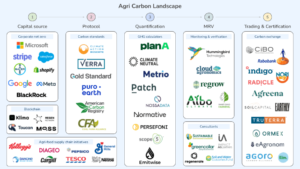Carbon Credit Exchanges
Carbon credit farming is a new way for farmers to earn income by selling credits that represent a reduction in greenhouse gas emissions. Farmers can sell these credits to companies or governments that are looking for ways to offset their own greenhouse gas emissions and make the planet a better place to live. Carbon credit farming is becoming more popular as more consumers and businesses become environmentally conscious and are demanding companies reduce their overall greenhouse gas footprint.
Companies and other entities that need to purchase carbon credits are usually required by law to do so with the help of an approved third-party verifier. The verifier will inspect the farm, take soil samples, and verify that the production practices being used on the farm are indeed reducing the farm’s carbon dioxide (CO2) output. Once the carbon credits are verified, they are able to be sold in the market.
Farmers can generate carbon credit exchange by implementing certain production practices, such as no-till and cover crops, which increase the amount of CO2 sequestered in the soil. Currently, groups from Cargill to the Nature Conservancy are running pilot programs for carbon markets in agriculture, and for-profit groups such as Indigo Ag are aggregating these credits to sell to companies like J.P. Morgan Chase and North Face.
While these programs are developing, it’s important for farmers to consider the requirements of each program carefully before signing a contract. These programs can vary in terms, payment structure, and participation length. Some require a minimum number of acres to participate, and others can restrict which production practices they will pay for. It is also important for farmers to review the potential breakeven prices of various production practices before enrolling in a carbon market program.

Carbon Credit Exchanges For Farmers
Once the carbon credits are verified, farmers can receive their payments. The amounts can range from $10 to $20 per metric ton of CO2-equivalent. The price depends on market conditions and the policies of each company. For example, some companies may not allow farmers to sell their credits to third parties and instead require them to stay in the program for a long period of time.
Some companies also limit the number of credits a farmer can earn per acre, which can affect a farmer’s ability to profit from this opportunity. It is therefore important for farmers to read the fine print on their contracts and seek legal advice before signing any agreements.
Many farmers choose to partner with a third-party aggregator to manage their carbon credit trading. These programs often offer a variety of benefits to farmers, including the ability to sell their credits in a more streamlined and efficient manner. They can also provide support and education on best practices to maximize the revenue potential of their carbon credit trading.
The key to success for a farmer in carbon credit trading is choosing the right partner and program. A good program will handle all the details for the farmer and ensure that they get paid for their efforts. They will also be able to provide support and assistance to the farmer during the verification process.